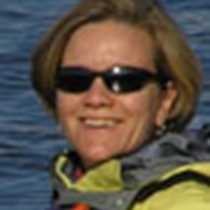Eastern Washington & Oregon
Although several of us have traveled along the Columbia River by car, few have experienced it as we did today. Learning about the geologic, human and natural history of the region, and engaging in conversation with shipmates and staff. Relaxing, while the ship’s officers do the driving. Savoring the fruits of the region with a wine and food tasting prepared by our hotel staff. This was the way we spent the first day of our voyage.
After embarking in Portland the previous afternoon, we motored up the Columbia through the night to awake just a few miles below the John Day Dam. This dam is distinguished by having the highest vertical lift lock chamber in North America, and one of the highest in the world. With a stiff breeze behind us, we delayed breakfast and entered the lock chamber at 7:25 a.m. Doubters soon realized that there was plenty of room for us, although it appeared initially as though we wouldn’t fit. Like all of the large dams on the Columbia and Snake rivers, John Day was constructed to generate electricity, hold water to irrigate the arid steppes above and ease the passage of river traffic by flooding the falls and rapids. All of these factors combined brought half a century of prosperity to inland communities; however, this prosperity has come at an ecological cost. Despite the construction of fish ladders and “juvenile fish passage devices” at all of the dams we’ve transited, historically rich salmon runs have been decimated. Coastal communities have borne the brunt of this decline, with canneries closing and fishermen forced to find other occupations. Communities all along the river, and various interest groups continue to converse about the fate of the salmon, and the fate of the river.
Today, aboard the Sea Lion, we had a variety of conversations about the river. We heard about Lewis and Clark and their exploration of the Columbia Basin. We discussed the geologic forces that shaped this Great River of the West, from ancient lava flows that cooled into giant basalt columns, to cataclysmic floods at the end of the last Ice Age. We marveled at the size and structure of the dams, and appreciated what feats of engineering they are. We even discussed commerce along the river when we saw grain barges pass by, and appreciated the productivity of the region with an evening wine and food tasting. All told, it was a fine first day of our voyage.
Although several of us have traveled along the Columbia River by car, few have experienced it as we did today. Learning about the geologic, human and natural history of the region, and engaging in conversation with shipmates and staff. Relaxing, while the ship’s officers do the driving. Savoring the fruits of the region with a wine and food tasting prepared by our hotel staff. This was the way we spent the first day of our voyage.
After embarking in Portland the previous afternoon, we motored up the Columbia through the night to awake just a few miles below the John Day Dam. This dam is distinguished by having the highest vertical lift lock chamber in North America, and one of the highest in the world. With a stiff breeze behind us, we delayed breakfast and entered the lock chamber at 7:25 a.m. Doubters soon realized that there was plenty of room for us, although it appeared initially as though we wouldn’t fit. Like all of the large dams on the Columbia and Snake rivers, John Day was constructed to generate electricity, hold water to irrigate the arid steppes above and ease the passage of river traffic by flooding the falls and rapids. All of these factors combined brought half a century of prosperity to inland communities; however, this prosperity has come at an ecological cost. Despite the construction of fish ladders and “juvenile fish passage devices” at all of the dams we’ve transited, historically rich salmon runs have been decimated. Coastal communities have borne the brunt of this decline, with canneries closing and fishermen forced to find other occupations. Communities all along the river, and various interest groups continue to converse about the fate of the salmon, and the fate of the river.
Today, aboard the Sea Lion, we had a variety of conversations about the river. We heard about Lewis and Clark and their exploration of the Columbia Basin. We discussed the geologic forces that shaped this Great River of the West, from ancient lava flows that cooled into giant basalt columns, to cataclysmic floods at the end of the last Ice Age. We marveled at the size and structure of the dams, and appreciated what feats of engineering they are. We even discussed commerce along the river when we saw grain barges pass by, and appreciated the productivity of the region with an evening wine and food tasting. All told, it was a fine first day of our voyage.




